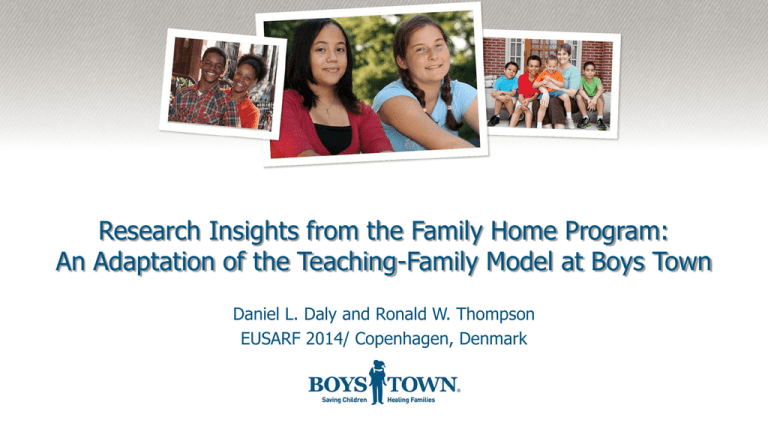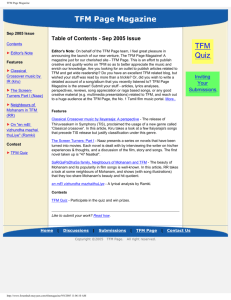Residential Advocacy Training
advertisement

Research Insights from the Family Home Program: An Adaptation of the Teaching-Family Model at Boys Town Daniel L. Daly and Ronald W. Thompson EUSARF 2014/ Copenhagen, Denmark 2013 Numbers Served Rate of Runaway Occurrences per 100 Residential Youth Served 100 Runaway Rate 80 60 40 20 0 73 85 97 09 4 74 86 98 10 75 87 99 11 76 88 00 12 77 89 01 13 YEAR 78 79 90 91 02 03 80 92 04 81 93 05 82 94 06 83 95 07 84 96 08 Teaching-Family Model (TFM) • Developed at Achievement Place, University of Kansas • • • • • Teaching Interaction • • • Family style environment staffed by highly trained couples Applied behavior analysis and social skill teaching Scaled up in several states across the US Practices developed in an applied research setting Core practice for changing youth behavior and teaching social skills Study results: Positively related to youth social skills and satisfaction and negatively related to delinquency Self government • • Youth lead regular family meetings Study results: Youth can establish consequences for peer behaviors TFM Model at Boys Town: Program Elements Teaching Skills and Building Relationships Supporting Religion and Faith Creating a Positive Family Environment Promoting Self-determination Focus on Safety, Permanence, and Well-Being National Program Replication and Implementation: Core Components Model fidelity • • • • Staff selection Staff training Supervision Evaluation and data support • Facilitative leadership Positive youth and family outcomes Ongoing quality improvement Research Evidence • Four US models of residential care have been identified as having at least promising research evidence by the California Evidence-based Clearinghouse for Child Welfare (cebc4cw.org) • • • • Positive Peer Culture Sanctuary Model Stop Gap Model Teaching Family Model • Four decades of research on the Teaching-Family Model • • • University of Kansas and other TFM sites Boys Town National Research Institute NIMH funded TFM study in North Carolina Results of Numerous Outcome Studies -Social Skills -School Functioning & Success -Pro-social Behavior -Positive Adult and Peer Relationships -Behavioral & Emotional Problems -Aggression -Delinquency (arrests) -Intimate Partner Violence Diagnostic Interview Scale for Children: Mental Health Symptom Improvement (During Care) Admission % of Youth Endorsing Disorder 100% 80% The change from admission to 12-months was statistically significant for all disorders (p<.05). 70% 60% 40% 12-Months 39% 38% 34% 25% 20% 10% 28% 14% 8% 5% 4% 8% 0% Any Disorder Disruptive Behavior 10 Mood Anxiety Substance Other Quasi-experimental Outcome Study: High School Graduation Rates (4 Years Post Discharge) 100% 83% 69% 80% 60% 40% 20% 0% Boys Town Group Comparison Group Research Insights with Practice Implications • Moderators of outcomes • Length of stay • Gender • Model fidelity • Mediators of outcomes • • • • Therapeutic alliance Positive teaching Family involvement Positive and negative peer contagion Longitudinal Outcome Study: Intimate Partner Violence (16 Years Post Discharge) • As adults, former Boys Town youth with a history of abuse or neglect had lower levels of adult Intimate Partner Violence (IPV) than expected from research. • Rates of IPV decreased with longer lengths of stay. Intimate Partner Violence Reports 40% 30% 20% 10% 0% • IPV rates for youth who were in the program for at least 18 months were virtually identical to the normal population. Expected < 18 mo. ≥ 18 mo. NSFH* Individuals with Histories of Maltreatment *National Survey of Families and Household Strengths and Difficulties Questionnaire (SDQ): Percent in Clinical Range at Intake and Discharge by Gender Male (n=377) Female (n=256) Percent of Youth in Clinical Range 60% 58% 56%*** 50% 51% 44% 42%*** 40% 36%*** 36%** 37%** 30% 27% 27% 25% 25%*** 22% 20% 15% 19% 16% 10% 0% Intake Discharge Total Difficulties Intake Discharge Emotional Symptoms Intake Discharge Conduct Problems *p < .05, **p < .01, ***p < .001; indicates statistically significant change over time on scale scores Note: sample consists of youth with SDQ caregiver-report forms at both intake and discharge Intake Discharge Inattention/ Hyperactivity Source: SDQ data collected in Home Campus Family Home Program 10/4/10 – 7/18/14 Studies Show Evidence of Positive Peer Contagion • In some environments children’s interactions with peers lead to increases in aggression, delinquency, and drug use. It is seen as a special concern in residential care settings. • Studies specifically examining this in a BT/TFM setting indicate that youth can experience positive instead of negative peer contagion: • • All youth had significantly fewer problem behaviors over time; youth with more serious problems showed greater improvement. Youth in homes with fewer peers who currently demonstrate problem behavior showed the greatest reduction in behavior problems. Current Research and Goals for the Future • Randomized trials of TFM adaptations to family intervention • • • • On the Way Home Common Sense Parenting In-Home Family Services Well Managed Schools • Community impact • • Parenting and family well being Youth risk e.g., substance abuse, aggression, school dropout • Neurobehavioral studies • Emotion regulation and aggression On the Way Home RCT: Post discharge placement stability Home/Community 100 Return to Care/Jail 4.9 7.7 90 23.1 12.2 25.6 30.8 80 70 60 50 100 92.3 40 100 95.1 76.9 87.8 74.4 69.2 30 20 10 0 Treatment Control n=39 n=39 Quarter 1 Treatment Control n=41 n=39 Quarter 2 Treatment Control n=41 n=39 Quarter 3 Treatment Control n=41 n=39 Quarter 4 Presenter Contact Information • Daniel L. Daly, Ph.D. • Boys Town Executive Vice President and Director of Youth Care • daniel.daly@boystown.org • www.boystown.org • Ronald W. Thompson, Ph.D. • Senior Director, Boys Town National Research Institute for Child and Family Studies • ronald.thompson@boystown.org • www.boystown.org/nri











